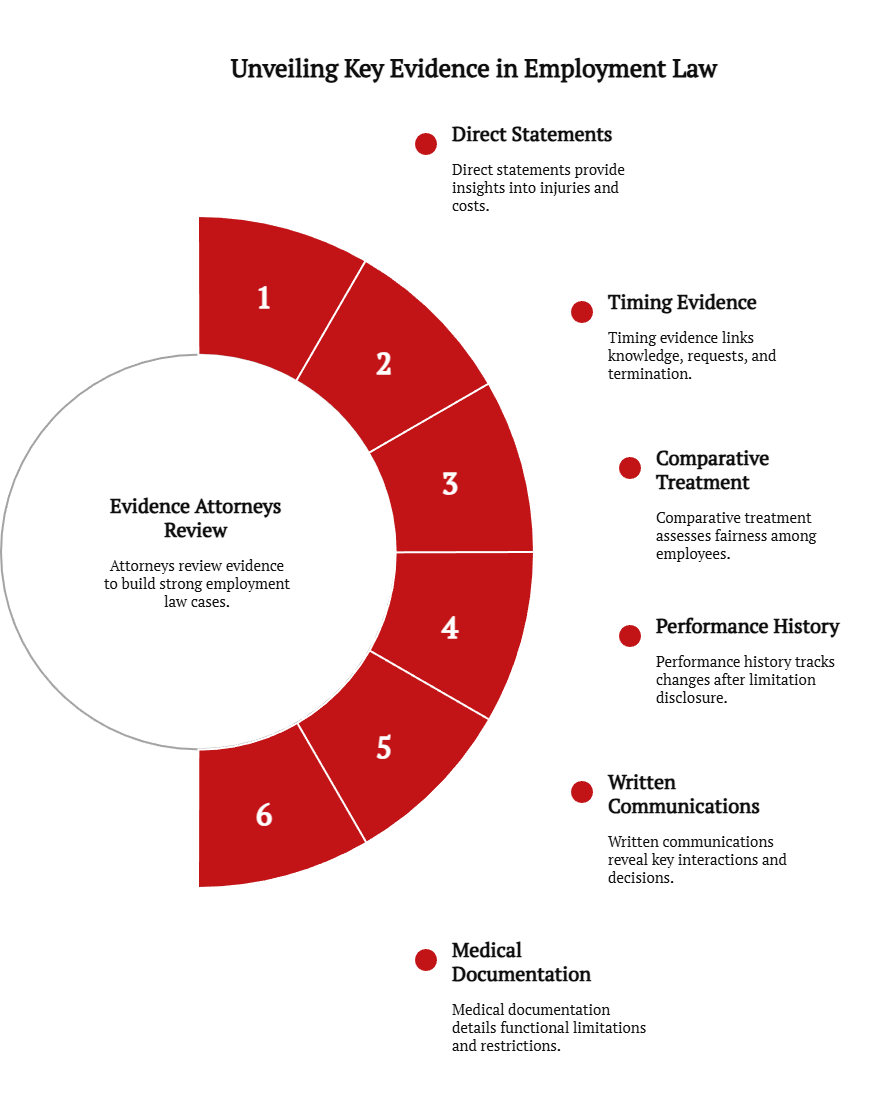📌 Key Takeaways
If you were fired soon after a bodily injury, California’s FEHA may protect you. Here’s how to spot the issues and respond wisely:
- Disability-Based Firing Is Unlawful Under FEHA: Employers may not terminate you because of a physical disability, including temporary injuries that substantially limit major life activities.
- The Interactive Process Is Mandatory: Once an employer knows about your disability, they must engage in a timely, good-faith dialogue to explore reasonable accommodations rather than dismissing requests.
- Retaliation Is Prohibited: Penalizing or firing you for requesting accommodations, disclosing a disability, reporting discrimination, or participating in investigations can constitute retaliation under FEHA.
- Timing, Remarks, and Paper Trails Matter: Close timing to disclosure, discriminatory comments, sudden negative write-ups, and departures from policy may help establish a disability-related motive.
Prepared, documented, and advised = stronger protection.
For California employees recovering from bodily injuries and wondering whether a sudden termination crossed the line, these insights clarify core protections and what to discuss with an employment attorney.
Losing a job after a bodily injury can be devastating. When termination follows soon after an employer learns of a physical disability —especially alongside remarks about health, ignored accommodation requests, or sudden performance write-ups—California’s FEHA may be implicated. In broad terms, the law generally provides that employers may not terminate workers because of a physical disability (see, e.g., Gov. Code § 12940).
This overview helps readers recognize patterns that may indicate FEHA issues. It is not a step-by-step guide. For case-specific analysis, speak with a California employment attorney.
What FEHA Generally Prohibits
FEHA generally prohibits disability discrimination in employment (Gov. Code § 12940). Coverage includes private employers with five or more employees in California.
A physical disability can include conditions that limit major life activities (e.g., walking, standing, lifting, bending, reaching). The concept may include: an actual disability, a record of disability, or being regarded as disabled. Temporary injuries may qualify when they substantially limit major life activities during their duration. Employer knowledge of functional limitations is often relevant to whether legal obligations are triggered (e.g., accommodation and the interactive process).
Employer Conduct That May Indicate Problems

The following indicators are illustrative, not exhaustive:
- Direct remarks about injuries, physical capability, or costs (e.g., “we need 100% healthy workers”).
- Close timing between disclosure of limitations or accommodation requests and termination.
- Sudden documentation of performance issues that begins only after injury disclosure.
- Departures from policy (e.g., skipping progressive discipline or applying standards inconsistently).
- Refusing to discuss accommodations or declaring “no accommodation available” without individualized assessment (see Gov. Code § 12940(n); verify current text).
Example (hypothetical): A worker provides medical lifting restrictions. Within a week, the employer ends employment for “inability to meet job requirements” without exploring equipment, modified duties, or reassignment. Outcomes depend on facts and law; this example is for illustration only.
The Interactive Process (Independent Obligation)
California law expects a timely, good-faith interactive process to consider reasonable accommodations (Gov. Code § 12940(n)). A common structure is:
- Recognize limitations: Employer becomes aware of functional limits affecting essential job functions.
- Clarify duties: Identify essential functions and how limitations interact with them.
- Explore accommodations: Consider options (e.g., modified duties or schedules, assistive equipment, leave as accommodation, or reassignment to a vacant position).
- Assess undue hardship: Evaluate effectiveness and feasibility in context.
- Document: Record discussions, options considered, and outcomes.
What is “reasonable” or an “undue hardship” is context-dependent. Consult a wrongful termination lawyer for tailored guidance.
Retaliation
FEHA generally prohibits retaliation for protected activity, which can include requesting accommodations, disclosing a disability, reporting discrimination, or participating in related investigations (Gov. Code § 12940(h)). Potential signs include close timing, shifting explanations, policy deviations, or negative remarks about accommodation requests. Whether conduct is retaliatory depends on the totality of circumstances and is assessed by the trier of fact (judge or jury).
Evidence Attorneys Commonly Review

- Direct statements about injuries, capability, or costs.
- Timing evidence linking knowledge of limitations, accommodation requests, and termination.
- Comparative treatment of similarly situated employees without injuries.
- Performance history before and after disclosure of limitations.
- Written communications (emails, texts, HR correspondence).
- Medical documentation describing functional limitations and restrictions.
Important: Do not make unlawful recordings or remove confidential/proprietary documents in violation of law or policy. Preserve information lawfully and obtain guidance from an experienced employment law attorney.
Potential Remedies (Vary by Facts and Law)
Where liability is established, remedies may include:
- Economic damages (e.g., back pay, potential front pay, documented out-of-pocket losses).
- Non-economic damages for emotional distress when supported by evidence.
- Punitive damages where legally warranted (Civ. Code § 3294).
- Attorney’s fees and costs for prevailing employees, as authorized by statute (Gov. Code § 12965(b)).
Availability and scope depend on specific facts and legal standards determined by the trier of fact.
Distinguishing FEHA Problems from Potentially Lawful Terminations
California employment is generally at-will, but discrimination, retaliation, and interactive process failures are not permitted. FEHA concerns may arise where disability is a motivating factor in an adverse decision or where the interactive process is not conducted in good faith. By contrast, terminations may be lawful when supported by legitimate, well-documented, non-discriminatory reasons (e.g., documented performance issues predating injury disclosure; genuine reductions in force affecting multiple roles; serious misconduct; or inability to perform essential functions even with reasonable accommodations after a good-faith process).
Disability and Bodily Injuries Under FEHA
FEHA’s disability framework focuses on functional limitations affecting major life activities, including but not limited to:
- Back injuries limiting lifting, bending, or standing
- Leg injuries affecting walking or mobility
- Shoulder injuries impacting reaching or carrying
- Neck injuries limiting range of motion
- Head injuries affecting concentration, balance, or coordination.
Coverage can extend to individuals with a record of disability and those regarded as disabled. Applicability depends on individualized assessments of functional impact (Gov. Code § 12940; verify current text).
Disclaimer:
This content is for informational purposes only. Laws, definitions, and deadlines change. Verify current requirements through official California sources. This content is not legal advice. No attorney-client relationship is formed through this content. Please consult a qualified attorney in your jurisdiction for legal advice specific to your situation.
Protect Your Rights | The Akopyan Law Firm, A.P.C. | Top Gun Employment Lawyers
Have you been wrongfully terminated from your job? Have you suffered discrimination, harassment, or retaliation in the workplace? Has your employer violated wage and hour laws? If so, we can help. The Akopyan Law Firm, A.P.C. is dedicated to protecting and enforcing employees’ rights throughout Southern California. With a 97% success rate and millions recovered for our clients, our team of experienced and talented employment lawyers can fight to secure the justice you deserve.
Take the First Step Towards Securing Justice: Call us today to speak with one of our experienced employment lawyers. The firm offers case evaluations free of charge.
Contact Us Today:
- Phone: (818) 509-9975
- Office Locations: Los Angeles, Bakersfield, Costa Mesa, Temecula, Rancho Cucamonga, Oxnard, Culver City, and San Diego in California.
Important: Contacting the Akopyan Law Firm, A.P.C. does not create an attorney-client relationship, but all communications will remain private and confidential. Each case is unique. The Akopyan Law Firm, A.P.C., does not guarantee any outcome.

